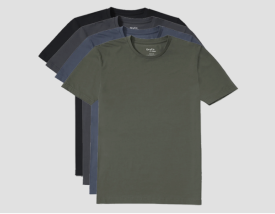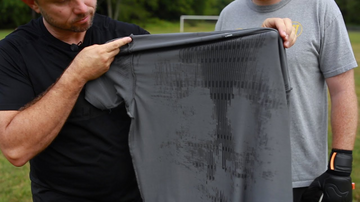Although they’re essentially two sides of the same coin, moisture absorption and moisture-wicking materials are NOT the same and have different functions. If you have hyperhidrosis, it’s crucial for you to know how they differ so that you choose fabrics that will keep you dry and comfortable the best. This post will compare moisture-absorbing and moisture-wicking materials and how effective they are for excessive sweating.
Moisture-Absorbing Fabrics
Clothing made with moisture-absorbing materials contains fibers that capture and hold onto sweat. Tiny gaps in the material called micropores, absorb water (which makes up 99% of your sweat) so that it doesn’t escape. These micropores, in effect, prevent sweat from leaking into other layers of your clothes.
A moisture-absorbing shirt, for example, will trap the sweat before it reaches the shirt, leaving you drier and your clothes free of sweat stains. Cotton is one of the most effective moisture-absorbing fabrics, hence, why people wear it to prevent sweat stains.
With that said, moisture-absorbing fabrics don’t function the same way moisture-wicking fabrics, despite the terms sometimes being used interchangeably.
Moisture-Wicking Fabrics
Moisture-wicking fabrics operate in a different fashion to moisture-absorbing ones. With moisture-wicking fabrics, water droplets remain on the surface and move around the fabric until they reach outside of the fabric. Once the droplets reach the outside, they are exposed to air, leading them to evaporate.
This happens through the process of capillary action, where molecular forces pull the liquid droplets through tiny spaces in the fabric so that they rise to the surface for evaporation.
The best moisture-wicking fabrics include the likes of merino wool and polyester. They’re commonly used among fitness buffs and outdoorsy-types especially, where staying dry in wet environments is essential. Clothing items made with moisture-wicking fabrics are also ideal for those who deal with excessive sweating (more on this later).
Moisture-Absorption vs Moisture-Wicking Fabrics
Let’s establish how moisture-absorbing and moisture-wicking fabrics are similar: they’re both designed to keep you dry and prevent your clothes from developing sweat stains. What sets them apart are the mechanisms of action they rely on to keep you dry and stain-free.
To put it plainly, moisture-absorbing fabrics capture sweat and hold it. Moisture-wicking fabrics capture sweat but take things a step further. Instead of holding onto the sweat, they pull it to the surface of the fabric so that it can evaporate.
The former works more like a sponge, whereas the latter works more like a water vacuum. With that said, the differences in their functions lead to different outcomes for sufferers of hyperhidrosis.
The Ultimate Showdown: Which is the Better Sweat-Resistant Material?
Ultimately, the question of which fabric is better for excessive sweating boils down to comfort and how severe one’s hyperhidrosis is. With that said, moisture-wicking fabrics have an advantage over moisture-absorbing fabrics.
Let’s look back at how they work. Moisture absorbing material captures and holds onto water, whereas moisture wicking-material pulls water to the surface where it will evaporate.
Since the water in a moisture-wicking fabric doesn’t stay in the garment, it will dry faster, meaning you’ll feel dry sooner, not to mention, less sticky and irritable. The speed at which moisture-wicking fabrics work also means sweat stains won’t appear since water can’t linger long enough for them to develop. If you suffer from moderate or severe hyperhidrosis (especially the auxiliary variant), then a moisture-wicking shirt is the most effective sweat proof shirt you can wear.
Our brand of Neat Apparel sweat proof shirts contain patented moisture-wicking fabrics and sweat-proof technology that keep you feeling and looking dry. You can wear them under a wide range of garments, both professional and casual, to prevent the feeling and appearance of sweat from becoming a distraction.
The Best Sweat Proof Protection You Can Get
If you’re looking for fast-drying protection, then moisture-wicking fabrics should be your number one choice. The fact that they pull sweat out of your garments allows you to feel and look drier faster than moisture-absorbing fabrics do.
And that will come in handy when you’re in situations where you can’t afford to feel and look sweaty at all. With a moisture-wicking shirt such as one of our NEAT Apparel selections, you can give yourself peace of mind that you’ll be comfortable even if the “sweats” come on.








